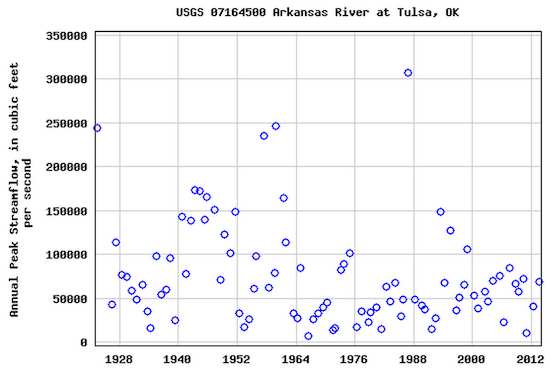By Sierra Rayne ——Bio and Archives--September 9, 2014
Global Warming-Energy-Environment | CFP Comments | Reader Friendly | Subscribe | Email Us
"'The messaging needs to be more on being prepared and knowing we're tending to have more extreme events,' said Graham Brannin, planning director in Tulsa, Oklahoma, where Sen. James Inhofe -- a global warming denier and author of a book labeling it 'The Greatest Hoax' -- once served as mayor. 'The reasoning behind it doesn't matter; let's just get ready.' ... In Tulsa, the city has been buying out homeowners and limiting development near the Arkansas River to help prevent flooding from severe storms. Although two lakes provide ample drinking water, Brannin is beginning to push for conservation with future droughts in mind. A nonprofit, Tulsa Partners Inc., is advocating 'green infrastructure' such as permeable pavement to soak up storm runoff."OK, fine. Let us focus on Tulsa. The climate record for the Tulsa area in the NOAA National Weather Service database begins in 1906. There have been absolutely no significant trends in average monthly or annual temperatures for Tulsa since records began. Exact same no-trend results for average and extreme monthly and annual maximum temperatures, with the sole exception of September -- whose mean and extreme maximum temperatures are declining, not increasing, over time (i.e., a cooling, not warming, trend). All the summer months have correlations towards cooling, not warming, maximum temperatures. The number of days each year above 95 F has a significant declining -- yes, declining -- trend since 1906, as does the number of days above 90 F, and the number of days above 100 F has a very near-significant (p=0.06) decline. Extreme heat is becoming far less of a problem over time in Tulsa. The number of cooling, heating, and growing degree days -- which affect air conditioning, home heating, and agricultural production, respectively -- also have no signs of significant trends since records began. No individual months have a significant trend in precipitation since records began, nor does annual precipitation. Same applies for maximum one-day precipitation amounts -- no trends either for any individual month, or annually. Also no trends in the number of days per year with more than one inch of rain, or in the number of days having more than two inches of rain. Tulsa's climate is quite remarkable in the absence of change during the past 108 years. If the city is spending any significant money on climate change studies, it looks like it is being entirely wasted. A couple hours of data analysis using free online datasets from NOAA-NWS tells you all you need to know about Tulsa's unchanging climate. And regarding that statement that "in Tulsa, the city has been buying out homeowners and limiting development near the Arkansas River to help prevent flooding from severe storms," here is the USGS peak streamflow graph for the Arkansas River at Tulsa, with data going back to the start of records in 1923:
 See any climate change induced impacts? Actually, there is a significant declining trend in the magnitude of the annual flood peak each year.
And as I've previously noted,
See any climate change induced impacts? Actually, there is a significant declining trend in the magnitude of the annual flood peak each year.
And as I've previously noted,
"There are no negative trends in annual precipitation for any of Oklahoma's nine climate sub-regions, either, over the past 120 years. None. There are no declining trends in summertime precipitation for the state as a whole, nor in any of its climate sub-regions, since 1895. None. You may also be interested to know that there are also no significant trends in Oklahoma's statewide average annual or summertime temperatures since 1895. What about the drought indices? Perhaps they are trending towards more drought conditions in Oklahoma over time? No. There are no trends towards declining Palmer Drought Severity Indices (PDSIs) for the state as a whole, or any of its climate sub-regions, since 1895 on 12-month, 24-month, 36-month, 48-month, or 60-month bases."The collective information herein should serve to debunk any climate hysteria for the Tulsa region. Of course the nonsense isn't limited to Tulsa. Grand Haven, Michigan -- right next-door to Grand Rapids -- is also featured in Flesher's article:
"Leaders in Grand Haven, a town of 10,600 in predominantly Republican western Michigan, will meet this fall with design consultants to explore such possibilities as 'cooling stations' for low-income people during future heat waves, or development restrictions to prevent storm erosion of the Lake Michigan waterfront."Cooling stations for low-income people during future heat waves in Grand Haven, Michigan? You have to be kidding? This is seriously on the municipal agenda?
View Comments
Sierra Rayne holds a Ph.D. in Chemistry and writes regularly on environment, energy, and national security topics. He can be found on Twitter at @srayne_ca